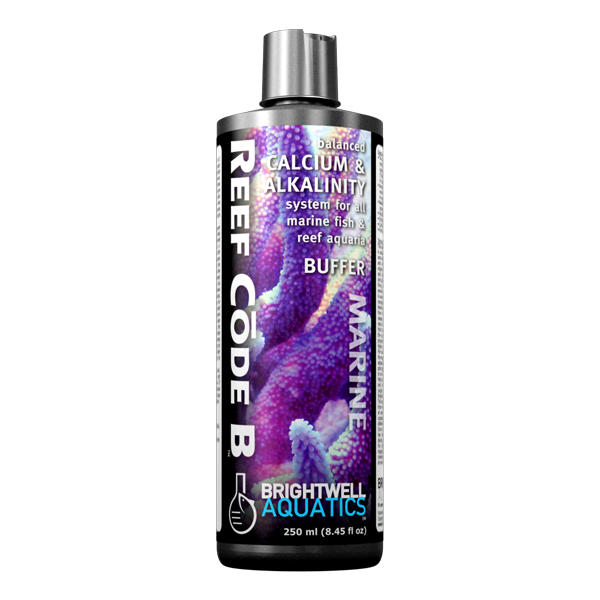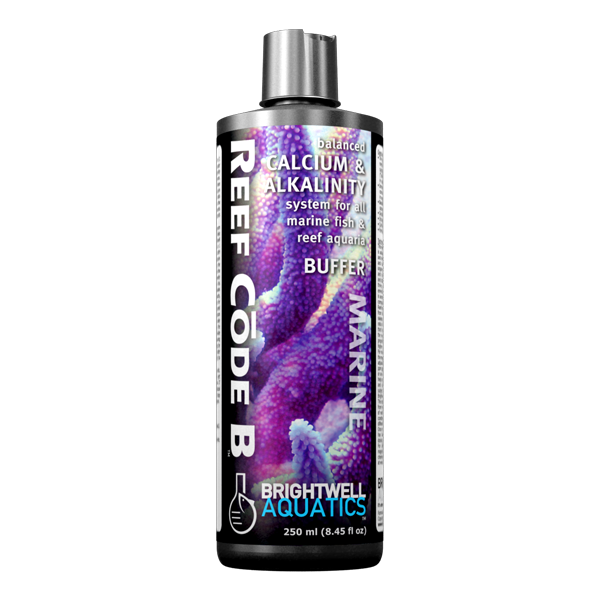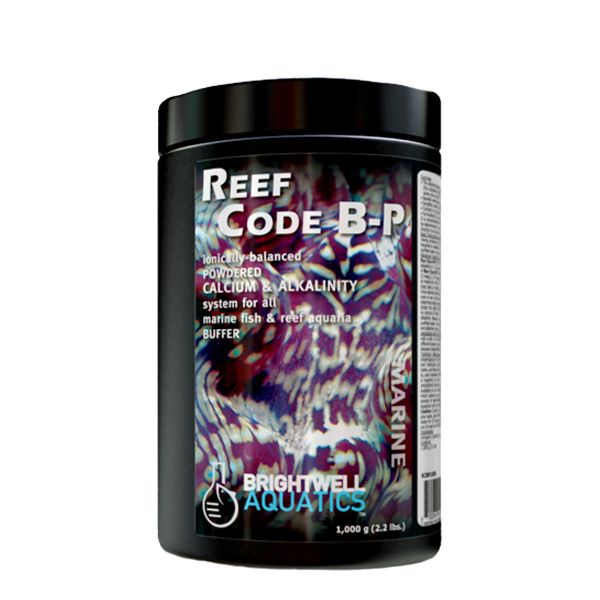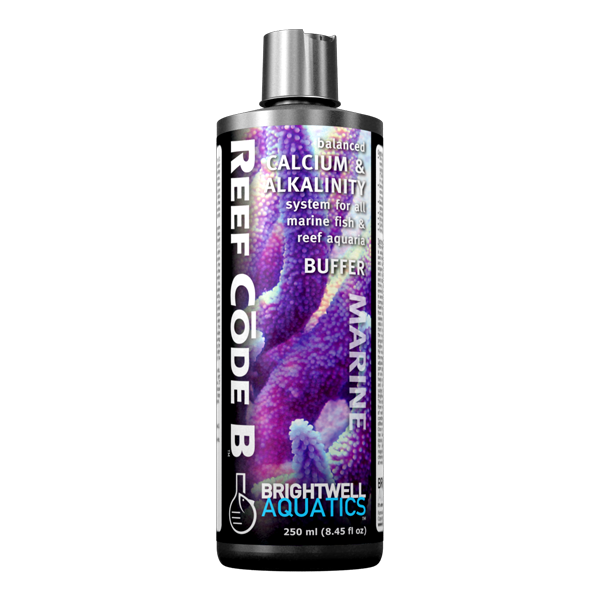Reef Code B
Reef Code B - Liquid / 250ml is backordered and will ship as soon as it is back in stock.
Couldn't load pickup availability
Reef Code B - Balanced Calcium & Alkalinity System
- The alkalinity-bearing component of a two-part method for dosing calcium and carbonates (the substances largely responsible for increasing alkalinity (”buffering capacity”)) in the same ratio as that found in natural seawater.
- Ionically balanced with respect to natural seawater concentrations of calcium and carbonates when used in equal amounts with Reef Cōde A.
- Benefits reef-building organisms such as corals, clams, calcareous algae, etc.
- Simplifies calcium and alkalinity maintenance.
- Stronger than most competing products.
- Contains no phosphate, silicate, or organic material.
Dosing Instructions | Liquid
Basic: Shake product well before using. Add 5 ml (1 capful) of product per 25 US gallons of aquarium water every other day or as needed to maintain the alkalinity within a range of 7 - 12 dKH. When used in this fashion, 250 ml treats up to 1,250 US-gallons (4,732 L). When used in equal amounts with Reef Cōde A, the calcium and carbonates being added are in the same ratio found in natural seawater. Do not mix products in the same container; this will cause the active components to precipitate and become ineffective. Allow 60 seconds to pass between dosing with Reef Cōde A and B.
Advanced: Determine the alkalinity in the aquarium using an accurate test kit before supplementing. Shake this product well before each use. Each ml of Brightwell Aquatics Reef Cōde B will increase the alkalinity in 1 US-gallon (3.785 L) of water by approximately 2.22 dKH (0.79 meq/L). If the initial alkalinity in the aquarium is below 7 dKH (2.5 meq/L), add this product at the maximum rate of 5 ml per 10 US-gallons daily until the desired alkalinity is attained, then dose daily or weekly as needed (see below). Note that each aquarium has different requirements for calcium and carbonates (which largely constitute Alkalinity or Buffering Capacity, hence pH stability); therefore, it is not uncommon for unequal amounts of Reef Cōde A and B to be required for obtaining and maintaining the desired calcium concentration and alkalinity. To determine the daily dosing rate for alkalinity maintenance: estimate the volume of water in the entire aquarium system; divide the daily decrease in alkalinity by 2.22 (when measuring alkalinity by dKH; divide by 0.79 when measuring by meq/L); multiply this number by the volume of water in the system to get the daily dosage required (ml) to maintain stable alkalinity.
Caution: Contains carbonate and bicarbonate salts; harmful if swallowed. If swallowed: give water, get medical attention. May cause eye or skin irritation. If in eyes, flush with water for 15 minutes, get medical attention. If on skin, wash thoroughly with water. Keep out of reach of children. Not for human consumption.
Dosing Instructions | Powder
Basic Instructions and Guidelines: Dissolve 20 grams per 8-fl. oz. of purified water in a clean mixing container and stir to dissolve; dose the resultant solution to the aquarium system as required to maintain the alkalinity within a range of 7 - 12 dKH. Up to 60 g per 8-fl. oz. of purified water may be mixed at once.
Advanced Instructions and Guidelines: Create a stock solution by dissolving 30 grams of REEF CŌDE B-P in 8-fl. oz. of purified freshwater; each ml of the solution will increase the alkalinity in 1 US-gallon (3.785 L) of water by ~1.0 dKH (0.375 meq/L). [Reference: Each g of REEF CŌDE B-P will increase the alkalinity in 1 US-gallon (3.785 L) of water by ~8.3 dKH (3 meq/L).] If the initial alkalinity in the aquarium is below 7 dKH (2.5 meq/L), add stock solution at a maximum rate of 10 ml per 20 US-gallons daily until the desired alkalinity is attained, then dose daily or weekly as needed (see below). Maintain alkalinity within a range of +/-1 dKH. Once desired alkalinity has been acquired, measure the alkalinity at the same time each day over a one- to two-week period to determine the required rate of alkalinity depletion. To determine daily dosing rate: estimate volume of water in entire aquarium system (US-gal.); divide the daily decrease in alkalinity by 2.1 (when reading dKH); multiply this number by volume of water in the system to obtain daily ml of stock solution required to maintain stable alkalinity. The maximum strength of the stock solution should not exceed 58.3 g RCBP per 8-fl. oz. purified water. Dose system as required to maintain desired calcium (using REEF CŌDE A-P) and alkalinity values. Do not mix solutions together; this will cause the active components to precipitate and become ineffective. It may be mixed individually in large containers and dosed with a drip- or automated-dosing system; ensure that solutions are entering the system in different areas to prevent precipitation. If adding manually, allow at least 60 seconds to pass between dosing REEF CŌDE A-P and B-P solutions.
Caution: Contains carbonate and bicarbonate salts; harmful if swallowed. If swallowed: give water, get medical attention. May cause eye or skin irritation. If in eyes, flush with water for 15 minutes, get medical attention. If on skin, wash thoroughly with water. Keep out of reach of children. Not for human consumption.
Technical Background
This method of calcium and carbonate supplementation is advantageous to hobbyists interested in a simple and effective solution to providing the very elements and molecules required for the growth of reef-building organisms such as corals, clams, and their allies. Corals and other reef-building organisms require adequate and stable available calcium and alkalinity if they are to thrive, regardless of how perfect the remainder of their environment is. Under most conditions, the mineral that is secreted as skeletal material is known as Aragonite, composed mostly of carbonate and calcium by weight. Reef-building organisms must extract these substances from the surrounding water in order to secrete new skeletal material for growth. By maintaining the same ratio of calcium ions and carbonates in an aquarium as that found in natural seawater, these organisms have the necessary building blocks available in the proper proportions, even if the hobbyist chooses to maintain higher concentrations of these substances.
For maximum effectiveness of the Reef Cōde method, the magnesium concentration in reef aquaria should be adjusted to and maintained between, 1,290 - 1,320 ppm before using these products (alone or together) or any other calcium and alkalinity products. Doing so helps prevent unwanted precipitation between calcium and carbonate ions.
The rate at which calcium and carbonates are extracted from the water is determined by the stocking density of reef-building livestock, type of lighting, and other conditions; therefore, each aquarium will have different requirements for the rate of supplementation. Once the rate of alkalinity depletion in the aquarium has been determined, the proper dosing rate of this product can be easily calculated.
Payment & Security
Payment methods
Your payment information is processed securely. We do not store credit card details nor have access to your credit card information.












